Mozzarella wrapped in branches: the world’s most sophisticated string cheese
Wild Cheese tour in southern Italy: part 2
See part one here, of the week long tour of Southern Italy I recently went on with Italian Food Hunters. This tour was the second segment of this year’s cheese travels that I’m calling ^MT25^OLBT^. One Last Big Trip.
If you’re interested joining for experiences like this, check out the website for a tour in Northern Spain this September, just before Bra. It’s a week long road trip visiting two cheesemakers a day, while eating at cider taverns and rural restaurants. Tasting cheese in the place it is made - while hearing its story told by the people who make it - is the ultimate way to gain a sensorial as well as intellectual understanding of why certain cheeses are so delicious. Feel free to message or email me for details, or view my IG posts.
Fausto and I sat down to taste after a tour of Azienda Agricola Le Starze, which sits on gently rolling hills above the Tyrrhenian Sea in Campania. Unveiling Mozzarella Nella Mortella from its botanical wrapping was a stimulating, sensual experience, taking its clothes off slowly, piece by piece. It’s a work of art, a bouquet, the packaging adding another strand to the webs of terroir that become increasingly complex the more I look into them, write about and experience them, become entangled in their delicious, nurturing matrix.
Strips of fresh cow’s milk mozzarella are blanketed with leafy branches of myrtle (Myrtus communis), a common plant in Mediterranean scrub communities. Its essential oils are anti-microbial, anti-fungal, repel insects, and can help slow the spoilage of foods. Using this plant in particular represents another expression of the knowledge of botanical chemistry of pastoral people. The cheeses are artfully hidden in the branches, tied up in little bundles. This was a method for packaging and transporting the cheeses before the invasion of progress popularized wrapping food in petroleum. The high moisture cheese absorbs a grassy citrus herbal aroma from the myrtle, a pleasant subtle flavor resulting from the practical packaging. It’s our choice, do we want our cheeses to be suffocated in a sheet of plastic, absorbing this essence, or do we want a cheese coated in an aromatic, medicinal, cancer-fighting plant that can be sustainably picked from the land on which the milk grows? Many other plants can be used, whatever is locally abundant, sturdy, and gastronomically pleasing. With this endangered cheese, another facet of natural cheesemaking is revealed, that of storage and packaging materials.
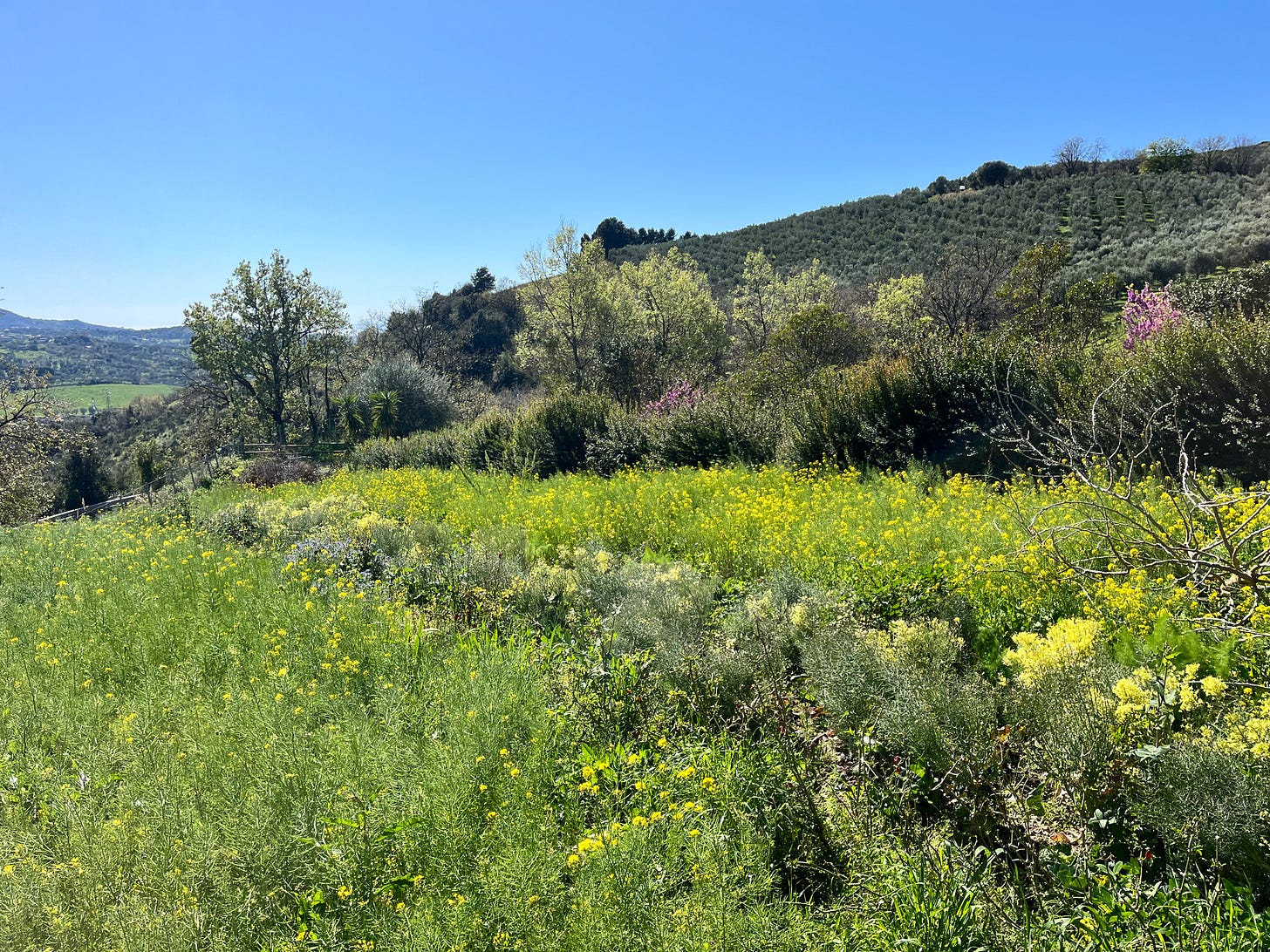
Made and wrapped that morning, the cheese is still damp with whey, and the aromas of sweet/sour milk are prominent. I slowly pulled one of the “tongues” of mozzarella into strings, studied it with my mouth, appreciated the tactile sensations that no kid doesn’t like. The accompanying elements of this tasting are equally simple, naked, and beautiful. A grainy sourdough from the nearby village, more hearty than most of the spectacular range of traditional breads found in southern Italy. Olive oil from the farm, bitter, spicy, complex, mountainous in character. This was the boldest flavor on the table. I could drink that olive oil, and I sopped it up with the bread, poured it on the cheese to offset its sweetness. A delightful crisp white wine from greco grapes, grown down the road, immaculate, round, and unassuming. This was not a pairing of gastronomic extravagance, there was no excessively verbose introduction. It consisted of taking the seemingly simple food and wine of the region, and putting it together on a table. It was never referred to as a tasting or pairing, and maybe it wasn’t. I appreciate this approach to service. “Here is food, eat. Here is wine, drink as much as you please.”
Each ingredient has an unmeasurable amount of hard work behind it, and multiple generations of accumulated knowledge. But none of that was forced on us, there was no selling of a story, none of the romaticisation that can be contrived, burdensome, and overplayed, especially in Italy. Each item simply existed, unadorned, speaking for itself, and together a perfect pairing emerged. It tasted like smiling. I know it’s good when I stop talking, and have to tell myself to slow down, to savor the moment. I know it’s good when I can’t stop eating, when each bite leads to the next, like a waterwheel being spun by a lazy river. A good tasting casually meanders, with no destination besides right where you are. A successful tasting is meditation, it brings you into the present moment, shuts down the chatter and obsessions of the prefrontal cortex, puts you back in your body. A good tasting isn’t a tasting. It’s eating with awareness, with feeling. You bite the cheese and say “yum”. You soak the bread in olive oil, “mmmm”. You take a drink of your wine, “ahhhh”, and feel refreshed, ready to start back at the beginning, as the wheel turns effortlessly, no beginning, no end.
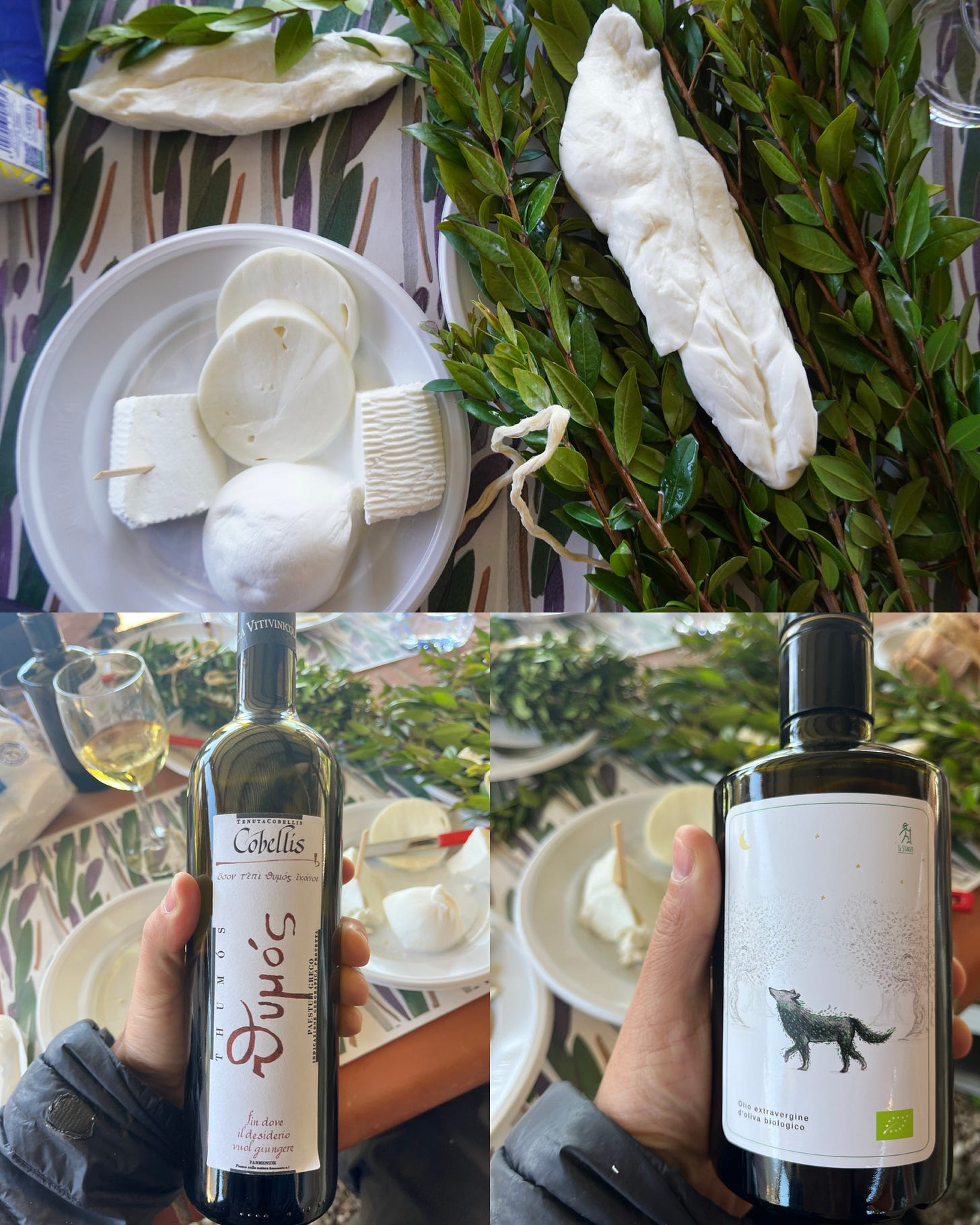
The older I get, the more of the diverse mountain ranges of cheese I traverse, seeing the extreme highs and lows, the more I appreciate the perfection that can be attained in cheeses that are 1 or 2 days old. Lightly fermented, lightly salted. Pure expressions of milk, before the admittedly fascinating and complex flavors from breakdown and aging begin. I like these cheeses that don’t require thought, that are not acquired tastes, that are not sophisticated fare for moldy cheese snobs to play tasting note word Tetris with. I love super fresh cheeses that anyone can appreciate, that kids, cats, and picky eaters will eat. They disappear off the cheese plate, and are so delicate that you should eat them with a clean palate, next to a very basic beverage that is there to refresh, and is as subtle as the cheese. These cheeses are ephemeral, so transitory that you can eat them every six hours and see them change, taste the acid grow, feel the texture soften, sense the salt penetrating from the outside in. After 3 or 4 days, they start to get yeast growth, and become another cheese, also interesting. But that day of the make, that hot ricotta in a bowl with its own whey, that tiny wheel salted at 2 hours of life and eaten that night, these have grown on me, and can really strike straight into my heart, like an arrow that flys past my intellect, leaving no opportunity for philosophical speculation and attempts at categorization. They fall into my mouth. They absorb directly into my being, almost immediately seeping back out my pores in a warm creamy glowing whey of the love of spirit for me, and me for spirit.
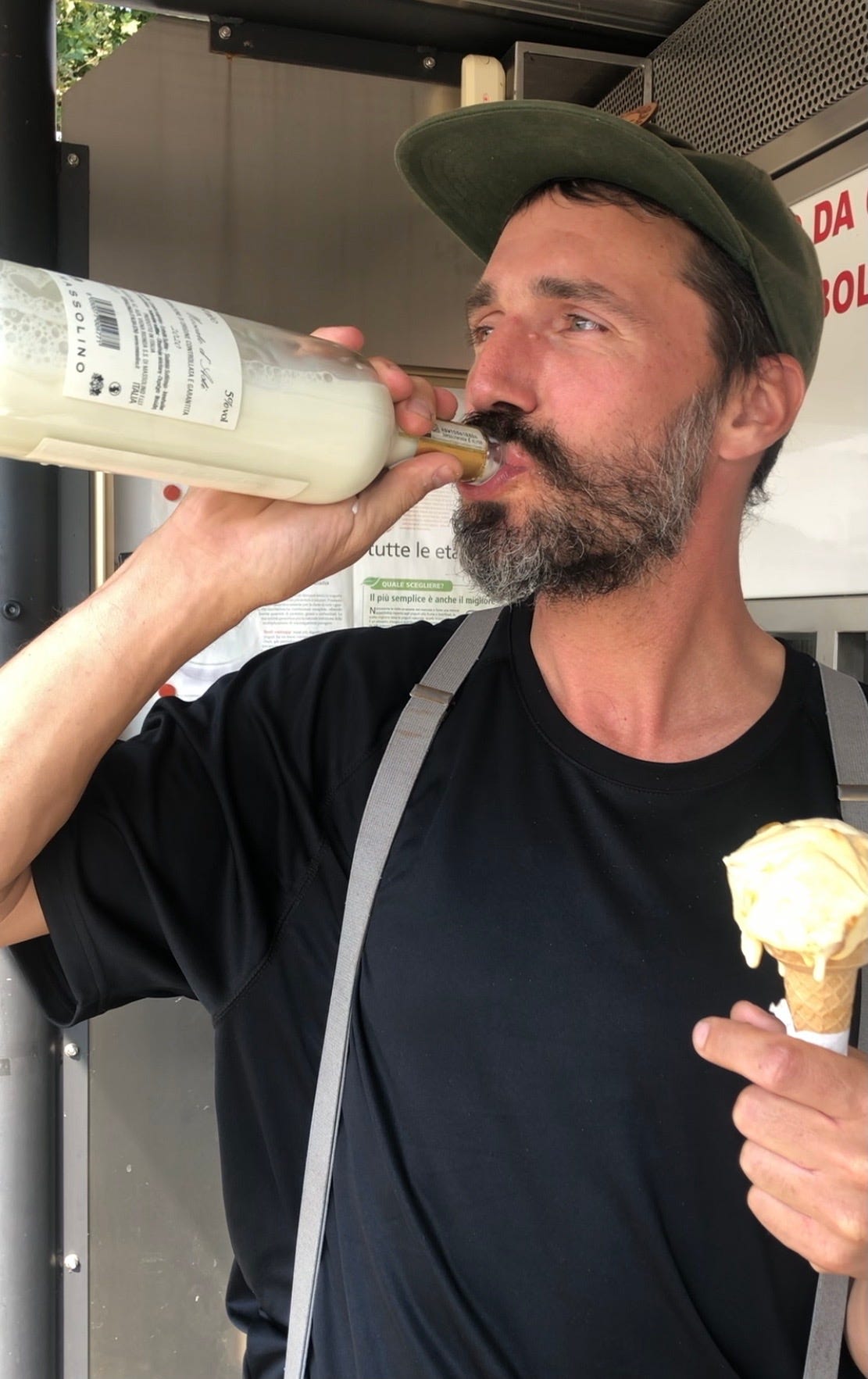
I’ll never forget sitting down at that table. The memory is a calm, glacially carved valley with a gurgling creek, crossed by the trails of wild animals and the occasional human. I’ll put it on my map, and a few of you fortunate souls may find your way there, to taste these foods in your own way, bringing your own assocations and history to the table. Some may find it boring. The cheese may seem undersalted, the olive oil too bold. A bread afficinado will perhaps be unimpressed, a wine snob find some defect or flatness. Sometimes we let the sophistication of our palates get in the way. We take our chosen obsession too seriously. I don’t think perfection is what I’m looking for. I like variety, novelty, and the beauty and authenticity of imperfection, of inconsistency, of biology. I’m less turned on by the perfectly even sous vide steak cooked in plastic than I am by the fire kissed roast that is overcooked on one end, undercooked next to the bone, that got a little burned down here and kissed the charcoal over there, has a little ash and crust patina, that was once alive, and now is dead, or somewhere in between.

Fausto and I are out here seeking wild cheeses, those with soul, barbaric things that have been pushed to the fringes by a culture that fears life. A lot of these cheeses are bold, with loud, assertive voices, that can offend enfeebled modern palates. And yet, it was this tasting of extremely angelic, approachable fresh cheeses that I found so impactful. We tasted many other cheeses on this trip. One of them completely knocked me off my feet. It’s the opposite of the delicate pasta filata’s discussed in these first two posts. It will be covered in part 3. Thanks for tuning in, I hope you look at fresh, soft, basic cheeses a little differently now. Try to stop thinking and talking, and just eat with your soul. I know i’m a hypocrite for saying that, but paradox and hypocrisy are part of my gig. I put them in the description when I invented this job. The best job on the planet. It’s not really work actually. It’s just me eating the world’s best and worst cheeses, while talking out my ass, every now then hopefully saying things that you can find value and meaning in.
Have you had powerful experiences like this while tasting cheese or other foods?
How has your palate for cheeses, shifted in the course of your life? How have your preferences evolved?
Would you be interested in joining a tour that involves a series of experiences such as what I describe here?
There are a range of options for how that could happen that I would be happy to suggest. Would that be valuable information to put together in a separate post?

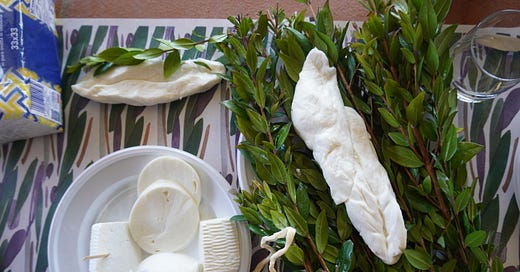



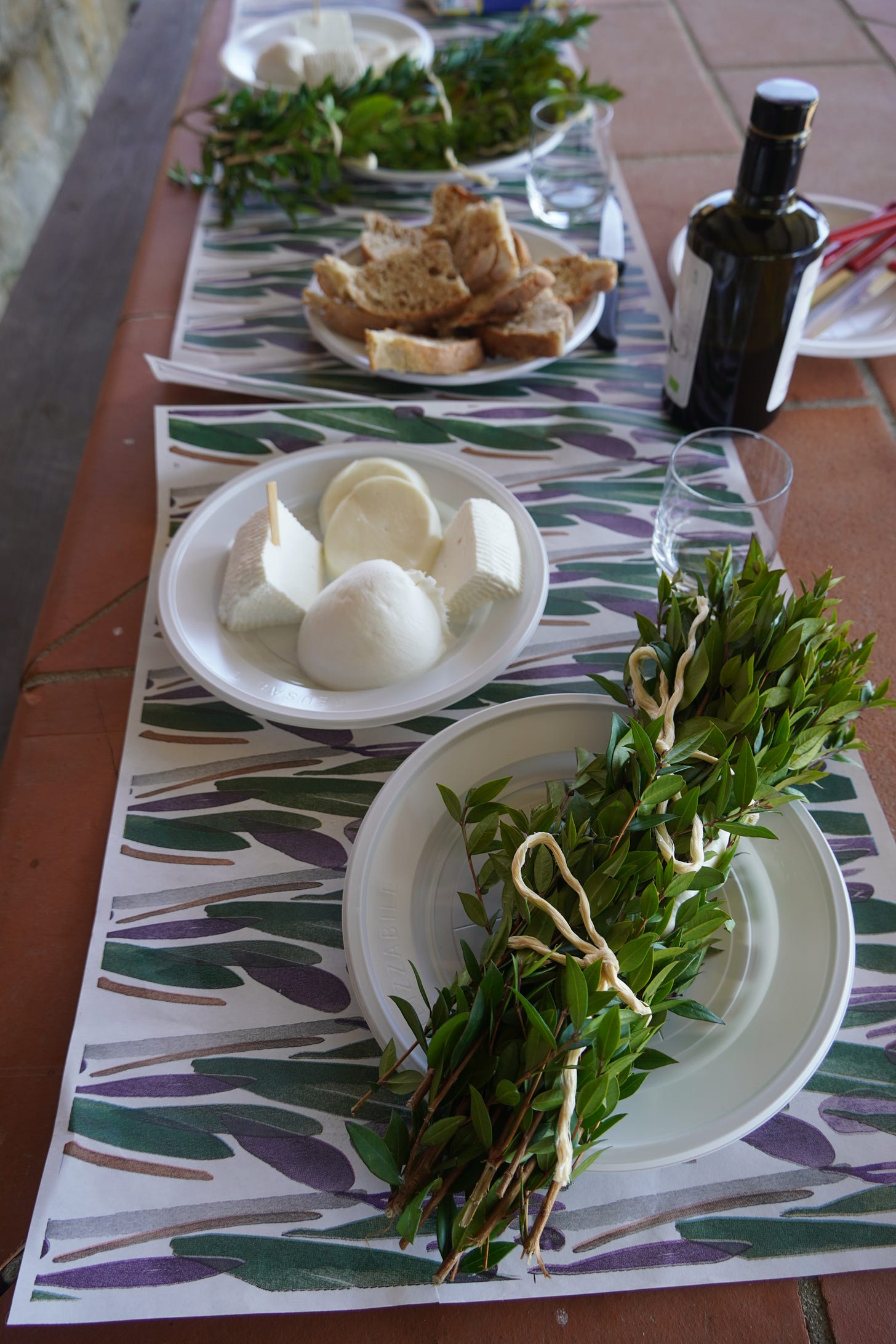

I do not have a cow or myrtle branches but I do have sheep with lambs and rosemary. I have no idea if sheep’s milk is conducive for a mozzarella-type cheese yet this is inspiring.
Wonderful piece. Reminds me how I love the simplicity of food culture in so much of Italy--yeah, people can over do it, over-romanticize, etc, but it seems like over there the baseline is an appreciation of the simple things and a knowledge of how to do them well, or where to find those who do. On my last trip, a longish walk in rural Lazio/Umbria, the thing that stood out was the variety of amaro on offer. Every host had a homemade rendition made with gentian or citrus peel or (my favorite) myrtle leaf. Incredible emerald stuff that took the ache from our tired feet. // Also, I have to ask: have you been to Sardegna?